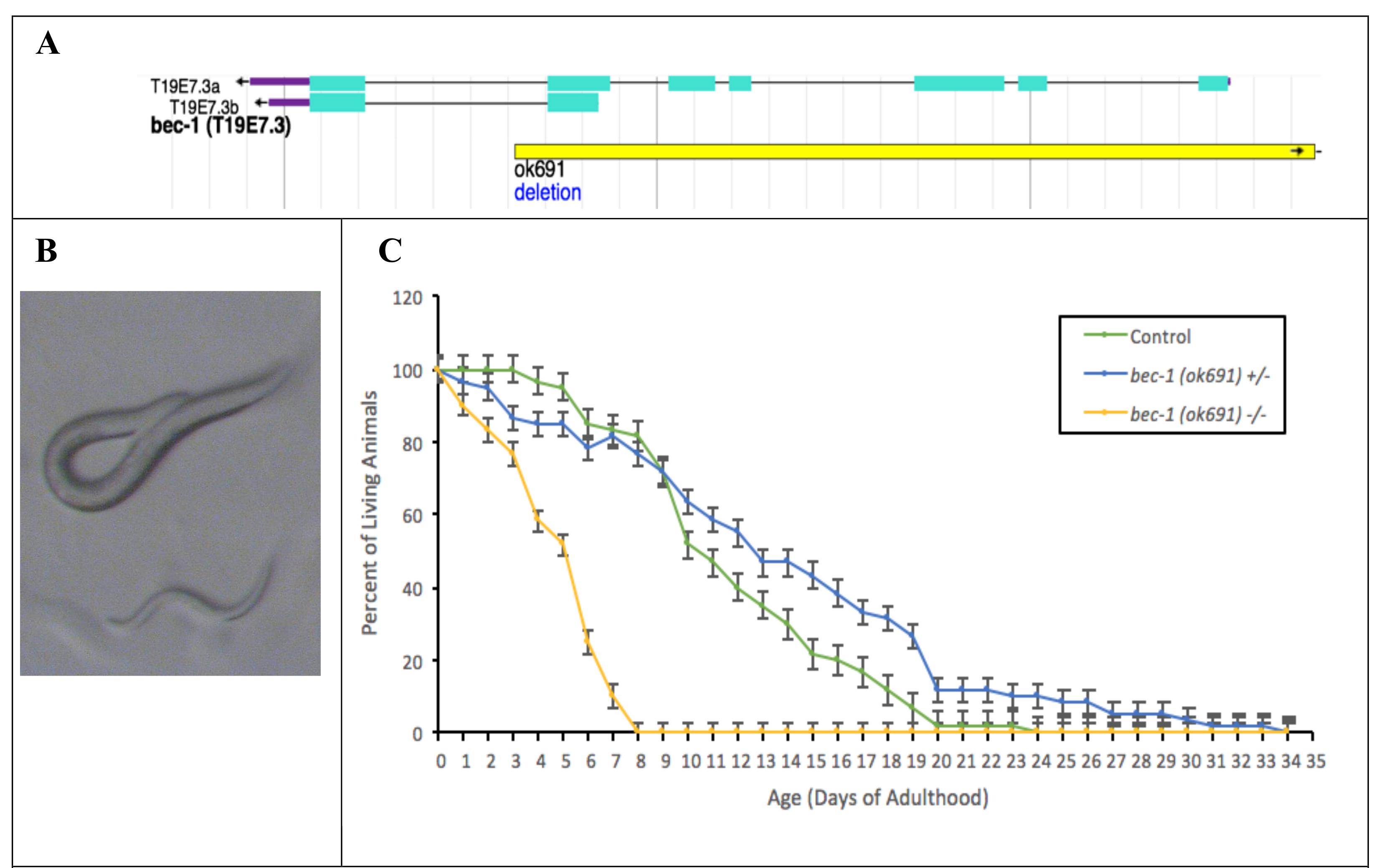Description
Macroautophagy (hereon referred as Autophagy) is a cellular housekeeping mechanism that uses a double membrane to target and engulf cell products forthe formation of autophagosomes. These double membrane organelles then fuse to lysosomes where cell products are degraded and recycled (Nakamura and Yoshimori, 2018). Reports show that autophagy plays an important role in pathogen defense, development, starvation adaptations, and aging (Mizushima et al., 2008). Identifying molecular mechanisms responsible for autophagy in mammalian cells has been possible as a result of studying model systems, such as Saccharomyces cerevisiae. Autophagy related genes (Atg) are evolutionarily conserved; therefore, research of autophagy in simpler organisms have informed the roles of Atg in mammalian cells (Ruck et al., 2011; Mercer et al., 2018; Tyler and Johnson, 2018). Analysis of autophagy mutants in C. elegansrevealed that bec-1/Atg6/Beclin 1 is essential for dauer development, a quiescent state that survives harsh conditions such as lack of nutrients, high nematode density, and high temperatures by inducing autophagy (Meléndez et al., 2003; Meléndez and Levine 2009).
To further investigate the phenotypes associated with the bec-1(ok691) mutation, we studied nematodes possessing a 3000 base pair deletion mutation (allele ok691) in the bec-1 locus (Figure 1A). Previous reports show that the bec-1(ok691) mutation is lethal, however a small proportion of homozygous bec-1(ok691) animals reach adulthood due to maternal effect, but do not reproduce due to sterility (Figure 1B, Melendez and Levine 2009). Our analysis of survival throughout adulthood shows that lifespan is significantly reduced in homozygous bec-1(ok691) mutants (Figure 1C). These nematodes do not live longer than 8 days of adulthood and 50% of animals died at day 5 of adulthood. In contrast, heterozygous bec-1(ok691) mutant lifespan is not significantly different from control animals, ruling out previously discovered haploid insufficiency effects of Beclin 1 for autophagic activity in C. elegans (Sinha and Levine, 2008). This conclusion should be considered as preliminary as we have not verified by an alternative line of investigation (e.g., a second allele or transgene rescue) that the observed phenotypes are specific to bec-1(ok691).
Methods
Request a detailed protocolSynchronizing:
Mixed stage nematodes grown on NGM plates at 20 °C were floated off using 1 mL of M9 reagent and collected in 1.5 mL tubes. Tubes containing animals were centrifuged at 9.3 × g for 1 minute. After centrifugation, the supernatant was discarded and the worm pellet was kept and treated with 1 mL of Alkaline Bleach (2.0% bleach (VWR), 0.5N NaOH) for 7 minutes at room temperature with occasional mixing. Once the 7-minute treatment concluded, bleached animals were centrifuged at 9. 3 × g for 2 minutes to collect eggs. Pelleted eggs were washed 3 times with 1 mL of M9 and centrifuged for 1 min. at 9.3 × g. After centrifugation, the supernatant was discarded and the pelleted eggs were suspended. Two drops of resuspended eggs were placed onto seeded NGM plates.
Lifespan:
Synchronous nematodes were placed on seeded NGM plates on day 0 of adulthood. A total of 3 replicas per group of 20 individuals were assessed each day for survival. Survival was defined as the presence of movement after nose touch and recorded daily. Living animals were transferred on a daily basis onto freshly seeded NGM plates. Lifespan was reported as percent of living animals over time.
Reagents
Strains CZ1200 and VC517 were obtained from the C. elegans Genetics Center. CZ1200 contains the transgene juIs76[unc25p::GFP] which drives the expression of GFP in d-type motor neurons. Strain AMH50 was produced in our laboratory by crossing CZ1200 with VC517 bec-1(ok691)/nT1[qIs51]. AMH50 possess the balanced lethal mutation bec-1(ok691)/nT1[qIs51] and the transgene juIs76, {bec-1(ok691) IV/nT1[qIs51](IV;V);juIs76[unc-25p::GFP] II}.
Acknowledgments
Special thanks to Dr. Stephen Steffenson for assistance with formal data analysis and Hailey Trombley for making NGM plates.
References
Funding
This work was supported by the National Science Foundation (award #1748523) and the Department of Biological Sciences at St. Edward's University.
Reviewed By
AnonymousHistory
Received: March 27, 2019Accepted: June 10, 2019
Published: June 14, 2019
Copyright
© 2019 by the authors. This is an open-access article distributed under the terms of the Creative Commons Attribution 4.0 International (CC BY 4.0) License, which permits unrestricted use, distribution, and reproduction in any medium, provided the original author and source are credited.Citation
Ashley, N; Holgado, AM (2019). The autophagy gene product BEC-1 supports normal aging and neurodevelopment in Caenorhabditis elegans I. microPublication Biology. 10.17912/micropub.biology.000099.Download: RIS BibTeX




